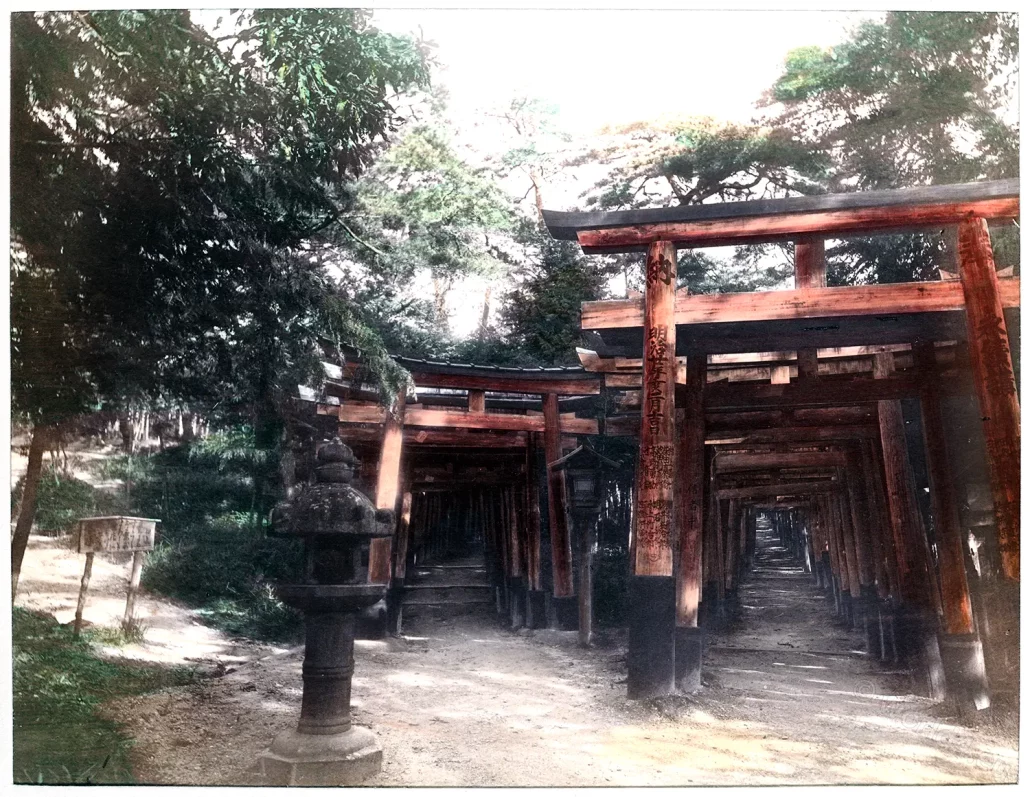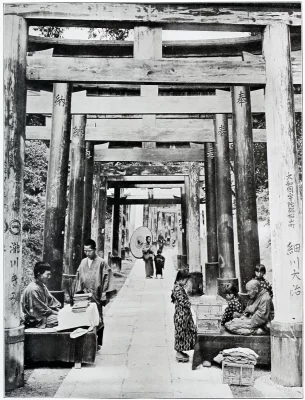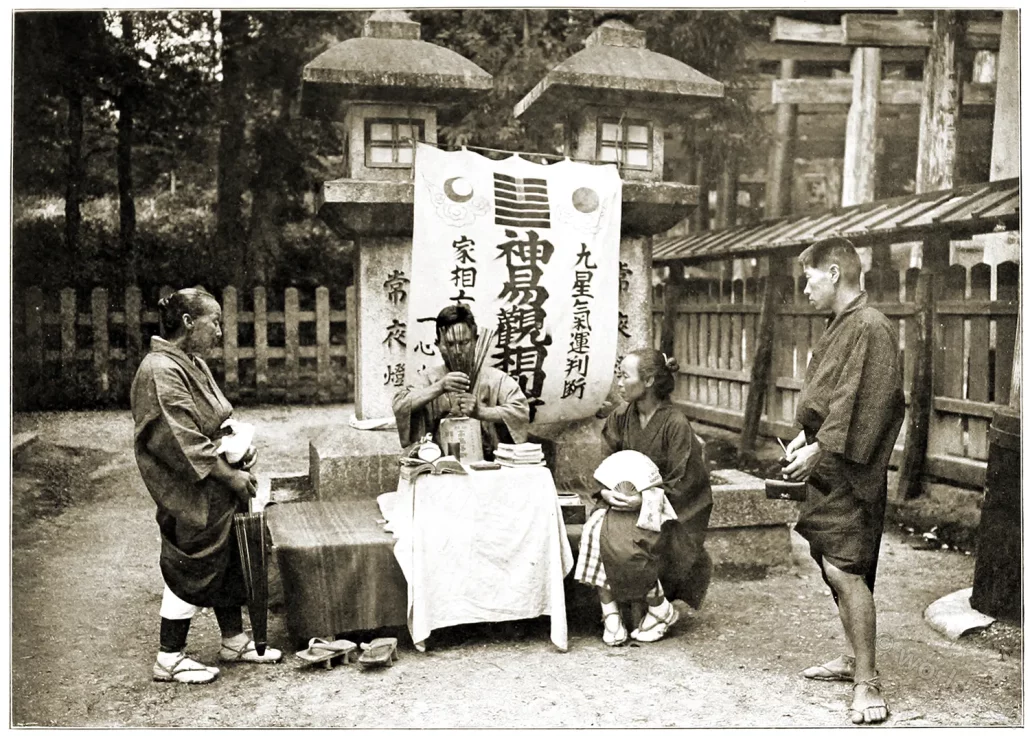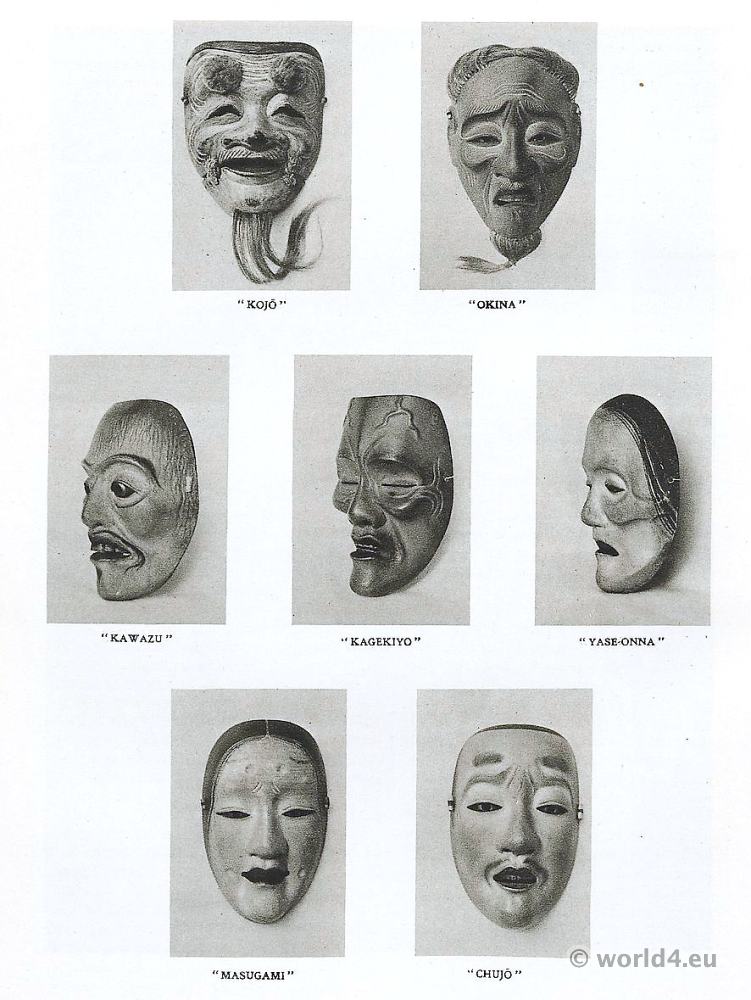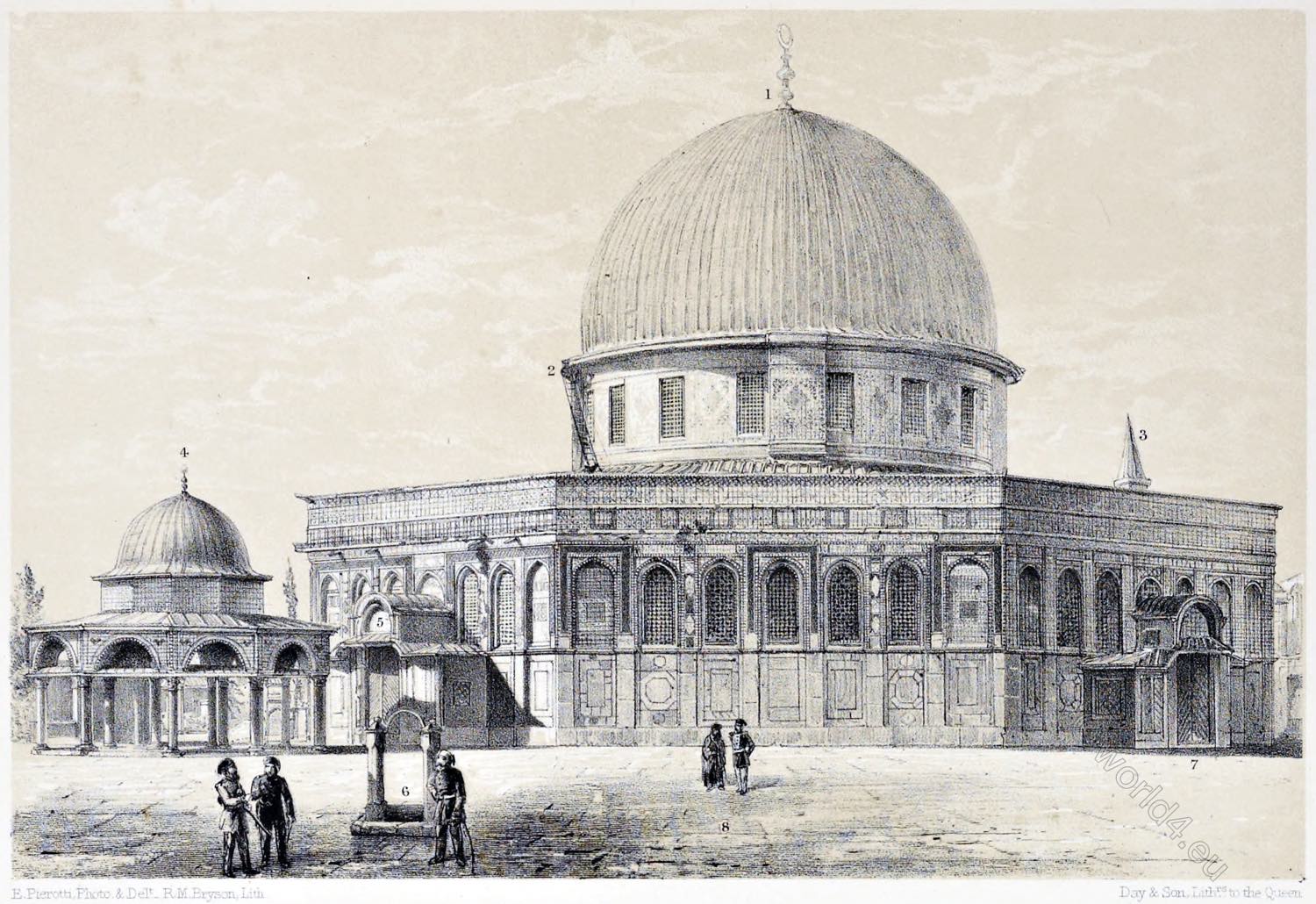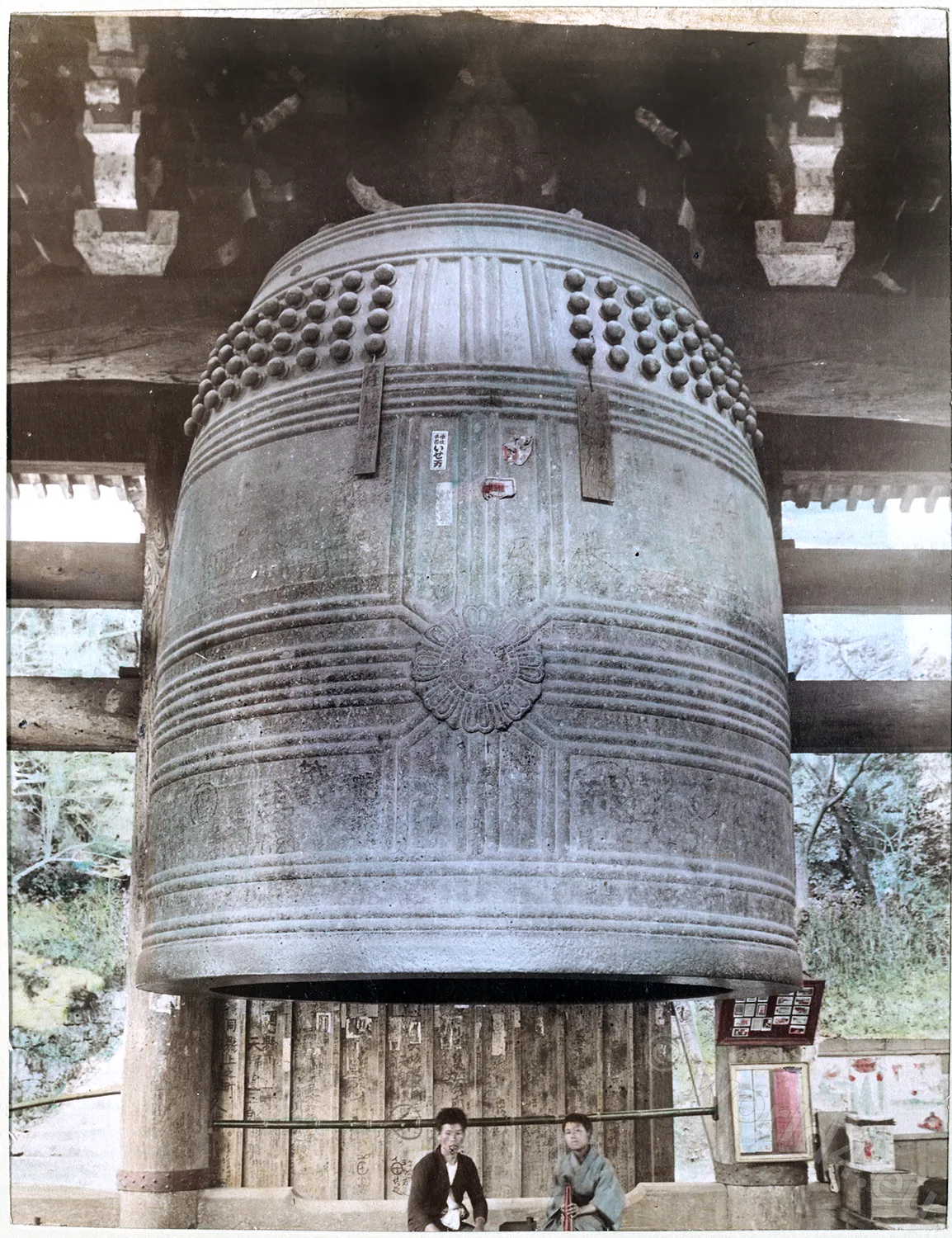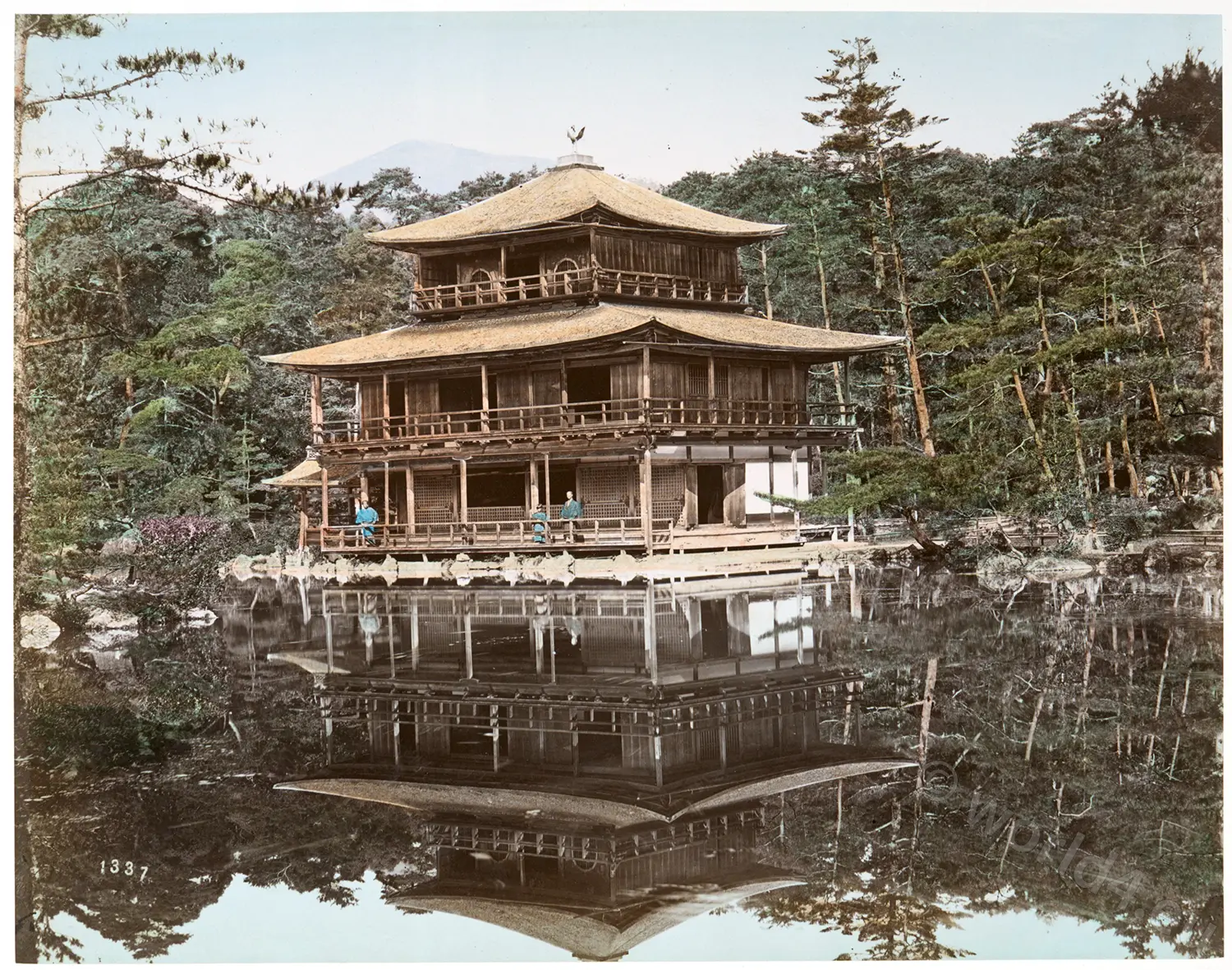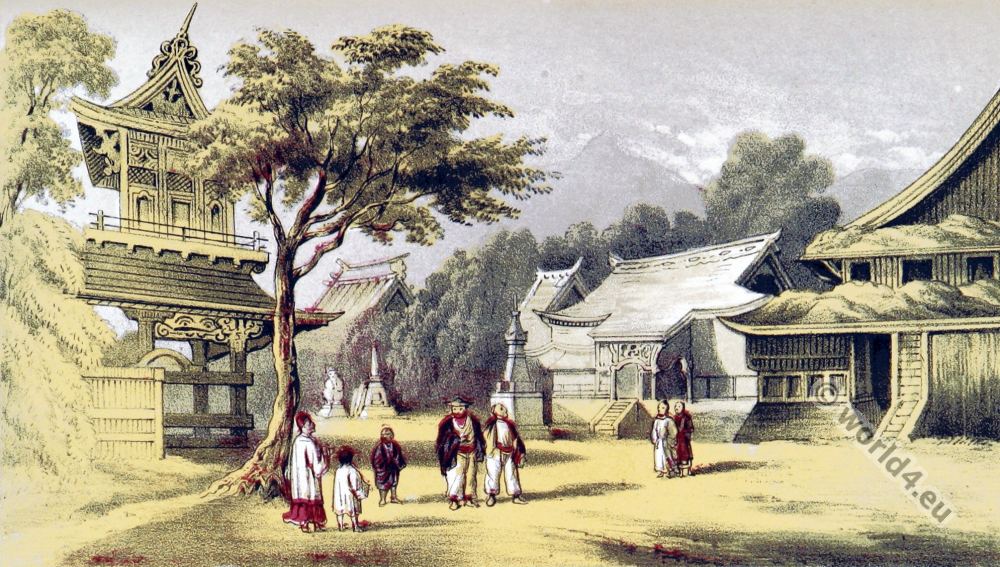The Fushimi Inari-Taisha (Japanese: 伏見稲荷大社, also known as Oinari-san) is a Shintō shrine in the Fushimi district of Kyōto city. It is one of the oldest and most famous Shintō shrines in Kyōto.
ENTRANCE TO INARI TEMPLE AT KYŌTO.
These colonnades, formed by red torii placed close together, lead to the Shinto Temple of Inari, the prototype of the thousands of Inari temples scattered throughout the country, which was founded A. D. 711, when the Goddess of Rice is fabled to have first manifested herself on the hill beyond.
From time to time these torii are presented to the temple, and each new torii is placed at the end of the colonnade, thus lengthening it. There are now over 400 in the two parallel colonnades, one of which is used in ascending the hill and the other in descending.
The famous Fushimi Inari is the most important of all the Inari shrines in the country, dedicated to the Shinto god Inari *). It is believed that foxes are the messengers of Inari, which leads to the many fox statues on the shrine grounds. The Fushimi-Inari Shrine has ancient origins, predating the relocation of the capital to Kyoto in 794.
*) Inari Ōkami, also known as Ō-Inari, is depicted as either male or female, sometimes seen as a collective of three or five individual kami (gods). He or she is the Japanese deity of foxes, fertility, rice, tea and sake, agriculture, industry, as well as general prosperity and worldly success. Inari is considered one of the most important deities of Shinto. In earlier Japan, Inari was also the patron of swordsmiths and merchants. Inari seems to have been worshipped since the foundation of a shrine on Mount Inari in 711 AD. Some researchers believe that worship began at the end of the 5th century.
INARI-NO-JINSHA or FUSHIMI-NO-INARI lying at the foot of Inariyama, a little beyond the Tōfukuji (Buddhist temple). It is a highest Government shrine dedicated to Uga-no-Mitama (Ukanomitama), the Goddess of Food or Rice, the deity Sadahiko-no-Mikoto (Sarutahiko Ōkami) and the deity Ō-Miyame-no-Mikoto.
According to tradition, the Goddess Uga-no-Mitama manifested herself on the peak of Inariyama on the first “Horse-day” (7th?) of February, 711 A.p., so that Irogu-no-Hata-no-Kimi, the ancestor of the Hata-Imiki family of Shinto, put up there a shrine in honour of the Goddess. Then it was removed to the present spot on January 5th of 1438 at the request of Yoshinori, the 6th Shogun of the Ashikaga Dynasty, while the shrine we now see was erected in August of 1589 by order of Toyotomi Hideyoshi.
Now, entering a red-painted wooden Torii and proceeding further on the paved path, the visitor comes to a two-storied gate, inside which stands an Oratory. Beyond in the east is situated the Main Shrine, a red-coloured handsome building placed under the ‘special protection’ of the Government. It is surrounded by several minor edifices such as the Dancing-hall, the Amulethouse, etc..
The most striking feature of the Inari-no-Jinsha is its innumerable red-coloured Tori scattered all over the ground and hillside leading to the Inner Shrine. They are presented by believers, numbering over millions, in token of devotion to the shrine.
The most interesting festival of the Inari-no-Jinsha takes place during the months of April and May, when five beautiful Shinyo or Shrine-cars are carried out by devout young people in the streets, accompanying the ‘Shinko’ or divine procession. Especially, three shrine-cars, the finest of its kind, are extremely well-shaped and exquisitely decorated with gold carvings costing hundreds of thousands of Yen. The procession starts for the Otabisho or Place of Sojourn on the 2nd ‘Horse-day’ in April and returns to the Main Shrine on the 1st ‘Rabbit-day’ in May according to the Lunar Calendar.
HATSU-UMA or First Horse-day is an annual festival celebrated on the ‘1st day of the Horse’ of February (Lunar Calendar), the day on which the Goddess Uka-no-mitama-no-kami (Ukanomitama, called Inari Ōkami-sama) is supposed to have made her first manifestation on the hill Inariyama in the year 711. It is truly a grand day when the shrine is visited by a huge number of pilgrims coming from far and wide.
Inari’s courtyards are the haunt of fortune-tellers and diviners, mendicant cripples, toy-sellers, and an old woman, who for the sum of three sen (three farthings) will liberate a small bird from a cage, thereby bringing to the donor of this amount some merit for the kindly act. For the sum of threepence one might free the whole of her stock in trade, and when I (Herbert G. Ponting) did so, giving the old beldame double payment, she chuckled with delight and was quite overwhelming with her benedictions.
The Japanese uranaisha, or fortune-teller, fills a very serious and material place in the estimation of the lower classes of the people. They resort to him in every conceivable form of trouble.
There are several uranaisha at Inari. The photograph shows one of them, in consultation with a woman of the peasant class, selecting his divining rods preparatory to instructing her in the matter concerning which she has come specially to Kyoto to see him, whilst her mother and brother stand by, anxiously awaiting the verdict of the oracle. The pair of ishidoro to which he has fastened his sign-banner are typical of the severity of the style of the stone lanterns at this temple.
The torii, characteristic of every Shinto temple, is not as nationally distinctive as some protest. Its whole meaning is a matter of contention. Most authorities claim for it Japanese origin as a perch for sacred fowls (tori), which time has modified to a mere “symbolic ornament.”
Kipling claims it is Hindu, and at Alwar, in Rajasthan, India, one Hindu temple that I visited has almost its exact counterpart. The beautiful pai-lo of China is the same idea in a more embellished form. Be its origin what it may, the torii is a very striking and effective structure, and its dignified lines are much beloved by native artists. The numerous torii at Inari are the gifts of devotees whose supplications have met with favourable response.
Source:
- JAPAN. Described and Illustrated by the Japanese. Written by Eminent Japanese Authorities and Scholars. Edited by Captain F. Brinkley (1841 – 1912) of Tokyo Japan. With an Essay on Japanese Art by Kakuzo Okakura (1860 – 1929) Director of the Imperial Art School at Tokyo Japan. 1897.
- In lotus-land Japan by Herbert George Ponting. London, Macmillan and co., limited, 1910.
- Sights of Old Capital by Aisaburō Akiyama. Tōkyō-to Yōshūsha, 1919.
Discover more from World4 Costume Culture History
Subscribe to get the latest posts sent to your email.

